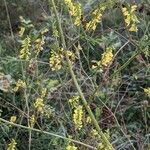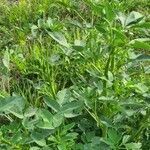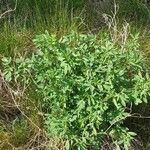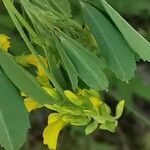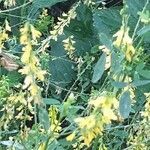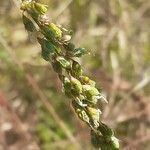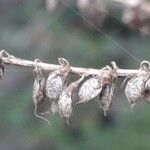Decumbent or erect biennial up to 1.5 m high; stems ± glabrous but sparsely hairy in upper parts. Lvs ± glabrous but sparsely hairy when young; petioles c. 5-25 mm long; leaflets narrowly to broadly elliptic or obovate, acute, obtuse or somewhat emarginate, mucronate, obtuse to cuneate at base, serrate, c. 10-25 mm long; stipules linear-lanceolate, entire. Racemes lax and slender, up to 20 cm long at fruiting; fls numerous. Peduncles > petioles. Calyx ± glabrous or sparsely hairy; calyx teeth mostly < tube, narrowly triangular. Corolla yellow, 4-6 mm long; wings > keel. Pod glabrous, transversely rugose, c. 3 mm long, 1-2-seeded; seeds light brown, 2-3 mm long.
Ascending or erect, taprooted biennial (annual) 0.5–1.5(–2) m; lfls oblanceolate to obovate, 1–2.5 cm; racemes 5–15 cm (peduncle included); pedicels 1.5–2 mm,decurved; fls yellow, 4.5–7 mm, the wings about as long as the banner; cal-teeth narrowly lanceolate, subulate; ovules 4–7; fr glabrous, 3–5 mm, strongly cross-ribbed; seeds usually 1 or 2; 2n=16. Native of Eurasia, established as a weed of waste places throughout our range, w. to the Pacific, not common southward. Summer.
A herb which takes 2 years to complete its life cycle. It can be erect or spreading. It grows 2.5 m long. The stems are branched. The leaflets are oval or sword shaped and have teeth. The flowers are yellow and 4-7 mm long. They are in loose slender clusters. The wings and standard are longer than the keel. The pods are oval and 3-5 mm long. They are rough and brown with veins across them.
